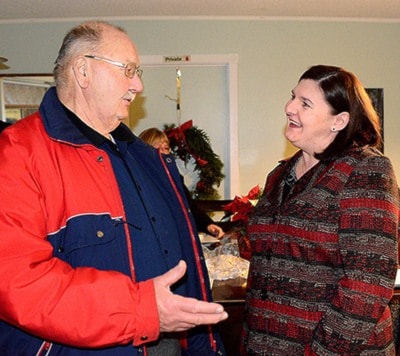Does the North Thompson Valley need a dedicated hospice facility?
If so, where should it be located and how should it be organized?
Those are some of the questions that should be answered by a feasibility study underway now, consultants Randy Sunderman and Sarah Matthews told a gathering of about two dozen people last Wednesday evening. The meeting was held at the Rivermount Cafe near Little Fort.
Those attending included volunteers from the Clearwater and Barriere hospice societies who already assist terminally ill patients and their families in their two communities.
The meeting was organized by the North Thompson Hospice House Society, which has obtained a Ministry of Health grant for the feasibility study.
Randy Sunderman of Lions Gate Consulting in Kamloops has the contract to conduct the study.
Originally from Clearwater, he is an economist with 21 years of experience.Sunderman is being assisted by Sarah Matthews, a nurse with extensive hospice experience – including writing an end-of-life policy for the provincial government.
The modern hospice movement began in 1967 when Dame Cicely Saunders established the first purpose-built hospice, St. Christopher’s in London, said Matthews.
Saunder’s insight was that it isn’t enough to minister to just the patient’s needs. It is also necessary to help the whole family unit through a time of stress and healing.
The Marjorie Willoughby Snowden Memorial Hospice in Kamloops did have a six-bed capacity until expanded to 12 in 2008, she said.
It is at 100% capacity with a waiting list. Patients come from as far away as Kelowna and Vancouver, as well as Kamloops and area. They are selected using criteria based on symptom control, not life expectancy.
Average length of stay there is 13 days, although this can vary from a few hours to several months.
All staff are specially trained, plus there is a big team of volunteers.
The emphasis is to make the hospice feel like a home, not a hospital.
With costs of about $500 per patient per day, the hospice is considerably cheaper than having a terminally ill patient in an acute care hospital.
The feasibility study process will begin by asking people for their visions of what a hospice for the area from McLure to Blue River would look like, Sunderman said.
There will be a needs assessment to identify the demand and what gaps need filling.
Best practices will be identified and options put together.
The study will also identify possible funding sources and make recommendations on side locations.
Sunderman estimated the feasibility study will be completed by the end of February.
